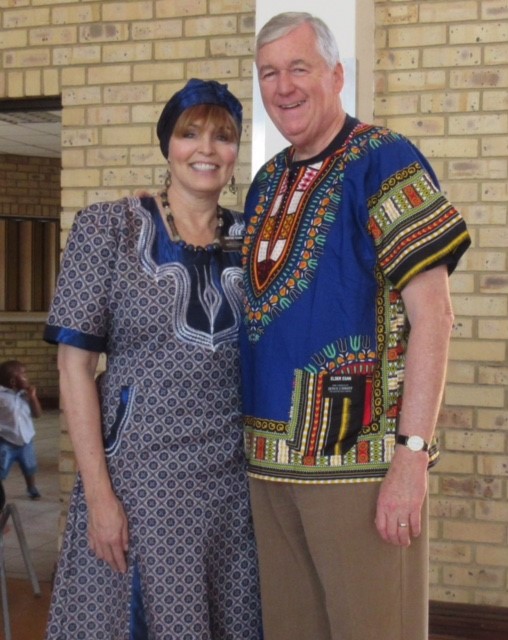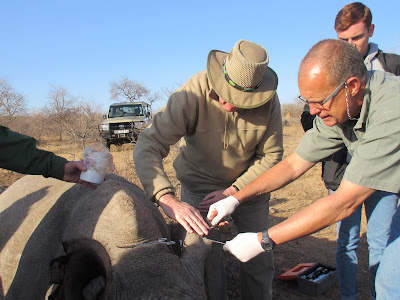The Rhino Safety Volunteer Program (RSVP) is dedicated to the protection and preservation of the rhinoceros population in Africa. In 2014, over 1,200 rhinos were poached in South Africa alone and their horns exported to Asia, where it is supposed they have some mystic medicinal and aphrodisiac qualities, although there is no scientific basis. Kruger Park relies on sponsor groups to tag and mark their rhino population in an effort to crack down on poaching. We got to be a part of that effort.
Our rhino recue began early, before dawn, at 5:30 Saturday morning, when it was still quite cold. We bundled up and boarded the two open Range Rovers and headed to the rendezvous point, where we met the ranger, the veterinarian and his assistant, and the DNA specialist, just as the sun was rising on the horizon, and received our assignments and training. The helicopter was to meet us at 7:00 am and landed at exactly 7:00 (straight up) in the open space right next to us.
 |
| The ranger educates us, instructs us and makes assignments while the DNA specialist stands beside him, nest to the truck |
 |
| The vet, with his dog Rex, explains all the drugs to be administered and warns about all the little things that could possibly go wrong, though none did |
 |
| The helicopter arrives at exactly 7:00 am |
 |
| Louise boards the helicopter to assist in finding the rhino to rescue |
 |
| Martha holds the rolled up socks to be used as rhino earplugs |
 |
| Watching the helicopter chase down the rhino to shoot him with the dart |
Two assignments were handed out at the lodge the day before, chosen in a random drawing. Louise Jorgenson's name was selected to ride in the helicopter and help find a rhino to save, and Shawn Boshoff was selected to ride in the helicopter while the darting of the rhino with a tranquilizer took place. The rest of us got our assignments during the ranger and vet training. Martha was assigned to stuff socks in both the rhinos ears, and Bob was selected to clamp the ears and apply coagulant to stop the bleeding after the ears were notched. Sharon Berg was the blindfolder and Sherry Weeks the one to hold the rhino's nose and horn and responsible for monitoring her pulse rate. There was an important assignment for almost everyone.
The rhino that was chosen was a mom with a young calf. The mother appeared to be about 12 years old and 13 months pregnant (out of 16). The challenge was to separate the two and isolate the mom so she could be tranquilized, notched on her ears (with the number 241, as she is the 241st rhino captured in this program) and have identifying microchips inserted in each horn and behind both ears.
 |
| You can see the small white dart that was shot and injected into the mother Rhino's rear end |
When the mother rhino was darted and suddenly disoriented, stopped in her tracks, unable to move her legs, and settled into a crouch, very dazed and barely conscious, the baby didn't know what to do, but she ran around in circles, seemingly trying to protect the mother and not leave her. When the helicopter was unable to chase her away, the DNA man's jeep took over and chased the calf out of the area, which was very sad and a very emotional thing to watch, especially for the mothers on our team.
Martha said she was especially struck by this example of absolute dependence of a child upon its mother, a metaphor for the intense devotion a mother has for her child. All her motherly feelings to nurture and protect came to the surface. We were all impressed by how much effort it took to get the calf away from its mother. The calf, which had probably never seen its mother helpless and had likely never been separated from its mother, was completely unwilling to leave its mother. The ranger and vet said not to worry, as mother and baby would be reunited very shortly after the anesthetic would wear off or the antidote administered.
The next thing to happen was to blindfold the animal, plug her ears, hook her up to oxygen and begin measuring her pulse. So Sharon, Martha and Sherry were the first ones out of the vehicle and into their job assignments. The vet then inserted a catheter into the veins of the rhino's left ear.
 |
| The ranger helps Sharon Berg throw a blanket over the tranquilized rhino's eyes, to keep the sunlight out and help her keep cool and calm... |
 |
| ...while Martha plugs her ears with socks to help keep the noise down |
 |
 |
| The vet looks on as the smaller horn is drilled and a microchip inserted |
 |
| While drilling, curls from the horn are collected as DNA samples |
While the horns were being drilled, the vet also implanted microchips beneath the skin behind each ear and took blood samples for DNA identification. Next, the ranger measured the outer and inner length of each horn and the circumference, while Debbie Boshoff recorded the data on her clipboard.
Six-year old Sara Boshoff is the youngest team member the project has ever had, and her assignment was to name the rhino. As soon as we approached the animal, Sean Donnelly commented, "Look how majestic she is!" We all nodded, and Sara immediately said, "That's her name... Majestic!" And it stuck.
Then it was time to notch her ears, and Bob took his place with the clamps and a black powdered coagulant to apply immediately after each notching, to stop the bleeding. The notches on the ears form a numerical code that can easily be recognized in the wild, even from the air, The notches made in Majestic's ears identify her as number 241. The notches in her left ear represent 200 (the tip) and 40 (lower left) and the upper right notch in the left ear represents the number 1. As a reward for doing his job, Bob was given the right ear notch of rhino skin as a souvenir and he held it up proudly.
Then each couple had their photo taken with Majestic, Anthony Berg (who is an anesthesiologist in Texas) administered the antidote, Martha took the socks out of the ears, and we had three minutes to get back in the van before Majestic awoke from the anesthetic and went to be reunited with her calf.

After the antidote was administered, Jason and David realized one of the safari vehicles had a flat tire. They had just 3 minutes to change it before the rhino revived, and they made it with a few seconds to spare, Majestic got up, threw off the blanket, and began the search for her baby, and our team was on the road back to the lodge by about 9:30 for breakfast, and mother and baby rhino were soon reunited.
 |
| Majestic is up and ready to roll barely 3 minutes after receiving the antidote |
 |
| The whole team leaving the scene in our two open Range Rovers. Bob is in the front seat of the far vehicle and Martha is on the far side of the back row with the two Berg boys |













No comments:
Post a Comment